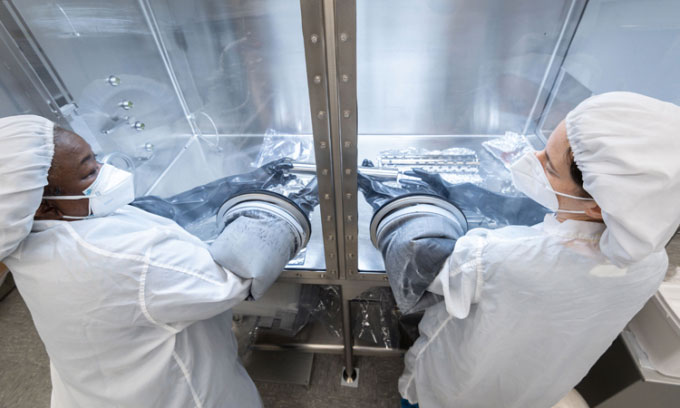NASA opens sample tube that can hold Moon gas for 50 years
Experts hope that the sample, which has been preserved for 50 years in a strict vacuum environment, will retain the lunar gas.
Over the past 50 years or so, geologists have been dissecting fragments of lunar rock samples brought back by the Apollos for analysis, yielding many important discoveries. However, there were two sample tubes that remained well preserved in a vacuum during this time. In particular, the sample tube brought back by Apollo 17 has just been opened for research, IFL Science reported on March 10.

Scientists are very cautious in the process of opening the lunar sample tube.
As technology advances, scientists can discover more and more new information from the samples that the six Apollo missions brought from the Moon to Earth decades ago. However, the gas mixed in the lunar material (if any) will escape during the time the samples are kept on Earth, making it impossible for experts to examine them with modern equipment. They expect two specimens placed in sealed tubes, never opened, to be the exception.
"For the past 50 years, samples of the Moon have been placed in a vacuum container, then put in another vacuum box," said Professor Alex Meshik at the University of Washington. The experts continued to put the sample box in a sealed Teflon bag and then put it in a nitrogen box, placed in a cellar to protect it from the atmosphere and light on Earth.
Meshik is part of a team of experts appointed by NASA to carefully open the specimen in the hope of determining if any gas exists, if so, is it primordial material from the Moon, or is it just permeable to any other gas? through careful preservation.
The amount of gas that can exist in this specimen will be very small. With careful extraction, scientists can analyze and identify these gases using modern mass spectrometry technology. The technology has evolved to the point of being extremely sensitive to the ability to precisely find out the masses of unknown molecules and use that data to identify them.
"Understanding the geological and evolutionary history of Moon samples taken from the Apollo landings will help prepare us for the types of specimens that could be encountered on future Artemis missions," said expert Thomoa Zurbuchen. at NASA explains.
The new study will reveal whether the Artemis mission requires more rigorous specimen sealing for the benefit of future generations of scientists, and provides useful information for future Martian rock preservation. this.
The Apollos landed at multiple locations far apart in hopes of capturing the Moon's diversity. The newly opened specimen was obtained from the sediments of an ancient landslide in the Taurus-Littrow Valley, in the 3.8 billion-year-old mountain range around the Mare Serenitatis plain. The specimen is buried so deep that during the lunar day (which lasts about two Earth weeks), its temperature never exceeds 0 degrees Celsius, increasing the possibility of trapped gases.
- NASA revealed the time of the first immigration settlement on the Moon
- Lava tube - a residence on the moon
- NASA conducts a recruitment examination on the Moon, 1 against 1,300
- NASA first opened a repository of samples taken from the Moon more than 40 years ago
- Two large meteors are flying towards Earth
- People can settle on the Moon in 2022
- 'Hell' does not light throughout ... 2 billion years on the Moon
- NASA hangs on the asteroid
- Hearing that Russia will go to the Moon to check, NASA rushes to prepare to send people to the Moon again
- NASA returned to the moon
- Detecting 200 suspected water holes on the Moon
- NASA announced 8,400 photos of the process of exploring the Moon
 Van Allen's belt and evidence that the Apollo 11 mission to the Moon was myth
Van Allen's belt and evidence that the Apollo 11 mission to the Moon was myth The levels of civilization in the universe (Kardashev scale)
The levels of civilization in the universe (Kardashev scale) Today Mars, the sun and the Earth are aligned
Today Mars, the sun and the Earth are aligned The Amazon owner announced a secret plan to build a space base for thousands of people
The Amazon owner announced a secret plan to build a space base for thousands of people